MESH, MESH COUNT
The terms, “mesh” and “mesh count”, are often used interchangeably and represent one of the most important concepts in the industry. Both “mesh” and “mesh count” refer to the number of openings per linear inch – a critical component when specifying wire mesh. To determine mesh or mesh count, start from the center of one wire and count the number of openings to a point exactly one linear inch away. For example, No. 4 mesh (or 4 x 4 mesh) indicates that, in one linear inch, there are four openings. Likewise, a No. 20 mesh (or 20 x 20 mesh) indicates that in one linear inch, there are twenty (20) openings.
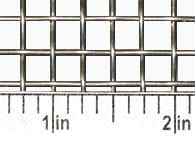
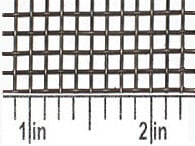
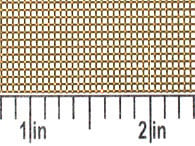
SPACE OR SPACE CLOTH
The term “space” represents the clear opening between two parallel wires as shown. “Space cloth”, as it is commonly referred to, is measured from the inside faces of adjacent parallel wires.
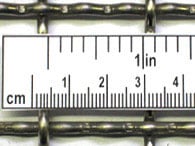
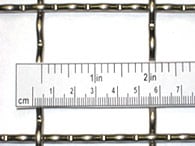
OFF-COUNT MESH
The term “off-count mesh” is commonly used to describe a woven or welded wire mesh that does not have the same mesh count in both directions. As a result, the mesh is not square, but rectangular. Off-count Mesh is often used in filtering and in sifting applications, as well as in unique architectural applications.
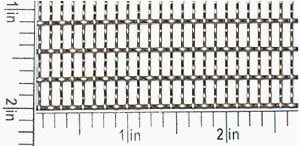
GAUGE OR DIAMETER WIRE
The terms “gauge” or “diameter wire” are often used interchangeably in the industry when specifying wire mesh, and they refer to the thickness of individual wires. Using decimals is preferred when stating wire diameter, since there are different gauge systems. To accurately measure the diameter wire, Darby recommends using a micrometer.
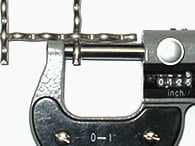
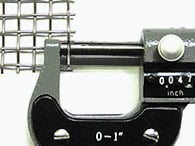
The chart below displays popular wire diameters alongside the generally recognized Washburn & Moen Gauge numbers that are used in the industry:
Edward J. Darby & Son, Inc.: Popular Wire Diameters and Corresponding Gauges |
|||
| Diameter Wire (inches) | Washburn & Moen Gauges | Diameter Wire (inches) | Washburn & Moen Gauges |
|---|---|---|---|
| 0.192 | #6 Ga. | 0.063 | #16 Ga. |
| 0.177 | #7 Ga. | 0.054 | #17 Ga. |
| 0.162 | #8 Ga. | 0.047 | #18 Ga. |
| 0.148 | #9 Ga. | 0.041 | #19 Ga. |
| 0.135 | #10 Ga. | 0.035 | #20 Ga. |
| 0.120 | #11 Ga. | 0.032 | #21 Ga. |
| 0.105 | #12 Ga. | 0.028 | #22 Ga. |
| 0.092 | #13 Ga. | 0.025 | #23 Ga. |
| 0.080 | #14 Ga. | 0.023 | #24 Ga. |
| 0.072 | #15 Ga. | 0.020 | #25 Ga. |
PLAIN WEAVE, ALSO PLAIN CRIMP
The majority of wire mesh that is manufactured and available from stock is woven in a “plain weave.” “Plain weave” refers to the method by which a wire mesh specification is woven – the warp wires, which run the length of roll, and shute wires, which run the width of the roll, pass over, one over, one under in both directions. This “over/under” weave locks the mesh in place, by virtue of the strength of the wires and the size of the opening.
Most plain weave wire mesh is usually manufactured on a rapier loom, which is recognized as one of the more efficient wire mesh looms in the world. In fact, generally speaking any mesh 3 x 3 Mesh or finer (i.e., 10 x 10 mesh or 50 x 50 mesh) is almost always woven in plain weave.
In recent years, a related term, “plain crimp” has emerged into everyday industry jargon, and while it is not an officially defined term by the ASTM 2016-06 standard for industrial woven wire cloth (defined below), it does provide clarity into this topic. “Plain crimp” is a simple, almost-natural crimp in which each intersecting wire interlocks with the next adjacent wire. Oftentimes, “plain weave” and “plain crimp” are used to convey similar concepts. Our own rule of thumb is that most, but not all, plain weave is plain crimp, but all plain crimp is plain weave. Indeed, the pictures below both show “Plain Weave” (one wire over/one wire under) and “Plain Crimp” (simple and natural crimp style):
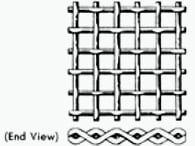
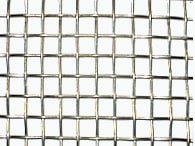
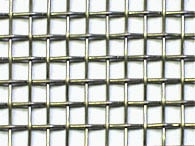
INTERMEDIATE CRIMP, OR INTERCRIMP
“Intermediate crimp” or simply “intercrimp” describes the popular crimp type that is used when woven wire mesh is manufactured. With intercrimp, both the warp wires (the wires that run the length of the roll) and shute wires (wires that run the width of the roll) are pre-crimped before the mesh is woven. Intermediate crimp is usually employed in coarser meshes to obtain large openings with relatively light wires. The hallmark of an intermediate crimp is the corrugations in the wire, which adds to the stability of the mesh. As a rule, the larger the opening size, the more number of crimps.
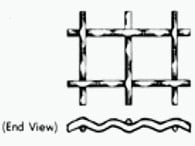
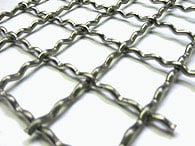
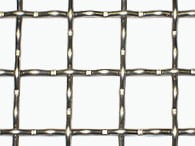
LOCK CRIMP
“Lock crimp” is a crimp type that is commonly employed when woven wire mesh is manufactured. Similar to intermediate crimp, “lock crimp” is also comprised of pre-crimped wires. The distinguishing feature of lock crimp is the bump or knuckle that forms over each intersecting set of wires. These knuckles lock the mesh in place and create an extremely rigid product. And finally, the wires on a lock crimp are straight between intersections, while the wires with the intermediate crimp are corrugated.
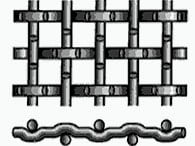
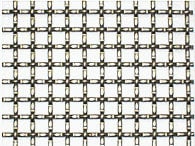
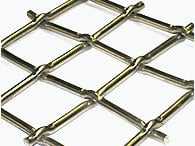
TWILLED WEAVE
“Twilled weave” is a weave type in which the warp wires and shute wires pass over two and under two in both directions. This is different from a plain weave, which is when the wires are woven one over and one under. As a result, “twilled weave” is often more pliable than a comparable plain weave wire mesh specification. By and large, twilled weave is often used in filtration applications. The images below illustrate twilled weave, but because twilled weave is usually reserved for fine mesh, identifying a twilled weave usually requires a mesh counter.
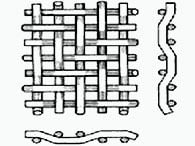
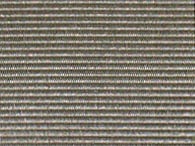
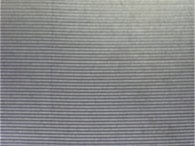
SELVAGE EDGE OR RAW EDGE
The term, “selvage edge” refers to the edge or border of wire cloth that has a finished edge. When wire cloth is woven, the shute wires are woven in, continuously, forming a smooth edge that runs the length of roll while helping to prevent unraveling on certain specifications. Generally speaking, a selvage edge will increase the stability of a mesh and provide a safety edge for handling. Looped selvage, as seen in the photo below, is the most common type of selvage edge. In recent years, selvage edge has decreased in popularity due to difficulty in producing and increased costs to produce. When a selvage edge is required, it is important to specify, as raw edge is widely the norm in the industry.
“Raw edge” refers to edging that is not continuously woven and is usually the result of manufacturing wire mesh on a rapier loom. In this case, the shute wires are uncovered, or raw. Raw edge is the predominant edge type in the industry, particularly on finer mesh (usually, 20 x 20 Mesh or finer). Further, raw edge is often preferred when customers are looking to keep their costs down. Both “selvage (looped) edge” and “raw edges” are shown below:
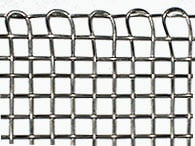
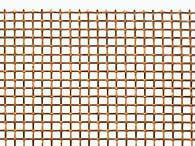
WOVEN VERSUS WELDED WIRE MESH
There are two ways in which wire mesh is typically manufactured: woven or welded. Considering the entire spectrum of possible wire mesh specifications in commonly used metals and alloys, woven wire mesh is the more frequently produced type of manufacturing process. This is partly a result of some limitations associated with the welded process. For example, some diameter wires are too thin and some opening sizes are too small to effectively produce a welded wire mesh. And of course, certain metals, including copper and aluminum, cannot be effectively welded into wire mesh.
Woven wire mesh is generally woven on looms, very similar to the looms that are commonly used to weave cloth. However, in this case, wires, not yarn, are used to produce wire mesh. The loom terms—heddles, reeds, and bobbin—are the same. Different patterns such as plain weave, twilled weave, and plain Dutch weave are made on these types of weaving looms. Usually, any specification that is 5 x 5 Mesh and finer is a woven wire mesh.
When the wire becomes too heavy for these looms, the wire must be pre-crimped. Wires travel through a crimping machine that crimps individual wires into the preferred style; these pre-crimp wires are then fed through the loom to assemble the mesh. The material remains stable and rigid by virtue of the mechanical properties of the wire, the space between the wires, itself, and the crimp style. Pre-crimp mesh can be woven in many different crimp styles, including plain crimp, intermediate crimp, lock crimp, and flat top crimp.
Over the past twenty five years, welded wire mesh has become very popular and highly demanded in the marketplace. Because the pre-straightened individual wires are welded at the intersections, relatively thinner diameter wires can be used over larger spaces. The mesh itself will remain strong and stable with a high percentage of open area. Stainless steel welded wire mesh has become very popular due to its clean appearance, uniform grid pattern, and attractive price point.
T-304 stainless steel, T-316 stainless steel, plain (or carbon) steel, and galvanized before (pre-galvanized) are the most commonly utilized materials when welded wire mesh is manufactured. Generally speaking, when a welded wire mesh has an opening size of 1-1/2″ x 1-1/2″ or larger, it is usually custom manufactured in flat sheet form, as opposed to roll form. When welded wire mesh has an opening size of ½” x ½” or smaller, it is usually available in 100FT rolls, which are often cut to size, depending on a customer’s requirement.
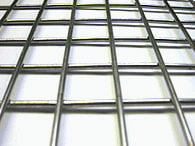
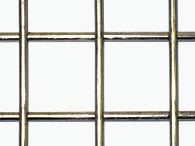
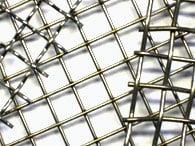
STANDARD (OR MARKET) GRADE, BOLTING GRADE, MILLING GRADE
Standard or market grade refers to a family of wire meshes that have a specific mesh count and a corresponding moderate diameter wire. Typically, these meshes offer high strength and a reasonable percentage of open area; they are normally found in stock and are regularly used in a broad range of applications. More information on standard or market grade can be found by clicking here.
Bolting grade is a specific group of wire meshes that are commonly, but not exclusively, used in sifting applications. These meshes are characterized by a thinner diameter wire and a higher percentage of open area, compared to a standard or market grade mesh. A bolting grade wire mesh is popular choice when higher throughput is needed.
Milling grade is also a specific category of select wire meshes that are commonly, but not exclusively, used in sifting applications. Milling grade wire meshes have diameter wires thinner than standard or market grade, but thicker than bolting grade. A milling grade wire mesh may be a suitable option for a user looking for a compromise between strength and opening size.
Usually, bolting and milling grade wire mesh are available in T-304 stainless steel and T-316 stainless steel. Below, please find technical information on this topic, as well as three photos of 20 x 20 mesh in bolting, milling and standard (or market) grade.
Standard, Bolting and Milling Grade Wire mesh: Technical Information Comparison |
|||||
| Category | Darby Item # | Mesh | Diameter Wire | Opening Size | % of Open Area |
|---|---|---|---|---|---|
| Standard | #20304.016PL | 20 x 20 | .016″ | 0.034″ | 46.2% |
| Bolting | #20304.009PL | 20 x 20 | .009″ | 0.036″ | 51.8% |
| Milling | #20304.014PL | 20 x 20 | .014″ | 0.041″ | 67.2% |

WARP WIRE, SHUTE WIRE
The “warp wire” is a technical term that describes the wires running the long way in a roll of wire cloth. Another way to define the “warp wire” is the wires that make up the length of a roll. The warp wires are the wires running horizontally, as the photo below depicts when a roll is standing on its end.
The “shute wire” is a technical term that describes the wires running the short way in a roll of wire cloth. Another way to define the “shute wire” is the wires that make up the width of a roll. Also referred to as the shoot, the fill, or the weft wires, the shute wires are the wires running vertically, as the photo below depicts when a roll is standing on its end.
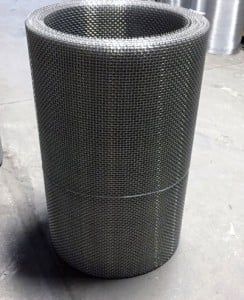
ASTM E2016-11
ASTM 2016-11 is the standard specification for industrial woven wire cloth. The purpose of ASTM E 2016-11 is to outline key terms associated with industrial woven wire cloth and to identify important tolerances and requirements used within the wire mesh industry. It also contains information related to blemishes, testing procedures, and packaging, labeling and certification. The entire specification is 29 pages, and can be accessed through visiting www.astm.org.
At Edward J. Darby & Son, Inc., we adhere to and are guided by this industrial woven wire cloth specification. In fact, many of the terms defined in our glossary section have been shaped by the definitions shared in ASTM E 2016-11. Further, we do encourage any individual interested in wire mesh to download and review this specification, as we find it useful, and often times, we reference it on a daily basis.
ASTM E 2016-11 applies to any primary metal or metal alloy wire that is suitable for weaving. It does not apply to welded wire mesh, insect screen or galvanized hardware cloth.
WIRE MESH, WIRE CLOTH OR WIRE FABRIC
Over the past 160 years that Edward J. Darby & Son, Inc. has been in business, terminology in the industry has evolved and changed. While these three terms – wire mesh, wire cloth and wire fabric –likely meant different things at different times to different people, in today’s marketplace, these three words are used interchangeably and all refer to the same product.
Today’s most popular term in the industry is wire mesh. It is used to describe virtually every item that Darby supplies to the world. This includes both woven and welded specifications as well as various metals and alloys, like stainless steel, copper and aluminum. Wire mesh is the most ubiquitous of the three terms, so much so that customers preface their requests by simply stating their need –‘mesh’.
The second term, wire cloth, is a bit less popular, but very important to the industry. In fact, ASTM E2016 recognizes wire cloth as the basic term for use throughout the industry. That said, it is not used, on a daily basis, the way that wire mesh is used. This is likely a byproduct of the term cloth, which usually connotes textiles. In today’s market, when a customer requests a wire cloth, it usually refers to a product that is on the finer end of the mesh count spectrum—for example, a T-304 Stainless Steel Woven Wire Cloth – 100 x 100 Mesh, .0045″ Diameter Wire. This wire cloth specification is very fine mesh that will behave more like a cloth than a rigid and stiff mesh.
The final term, wire fabric, is the least popular of the three and is usually only used in certain purchasing circles. For instance, wire fabric is commonly used in most U.S. government solicitations. Also, welded wire fabric (WWF) is often used in the construction industry. Finally, and perhaps most notable, the terms welded wire fabric, or welded utility fabric was once a popular term to describe a certain category of specific meshes that were used in fencing and enclosure applications. Generally, welded utility fabric referred to low cost, highly versatile galvanized welded wire mesh.

Connect with Darby